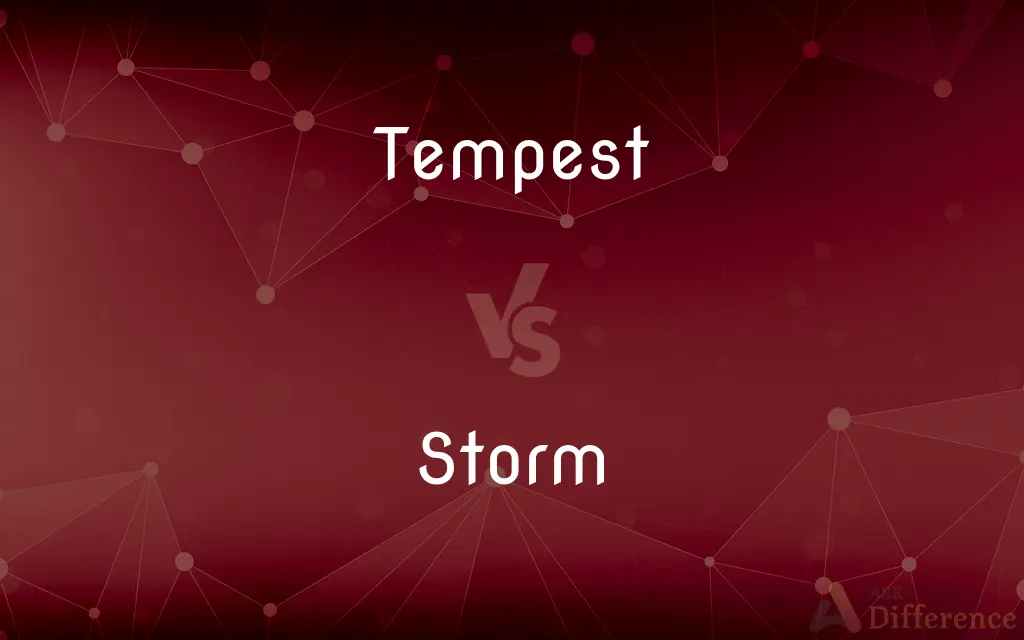Tempest vs. Storm — What's the Difference?
By Tayyaba Rehman & Maham Liaqat — Updated on March 6, 2024
A tempest is a violent windstorm, often accompanied by rain, hail, or snow. A storm is a broader term, referring to any disturbed state of the atmosphere, especially affecting the earth's surface, and implying inclement weather conditions.

Difference Between Tempest and Storm
Table of Contents
ADVERTISEMENT
Key Differences
A tempest is characterized by its intensity and the violence of its wind, making it a specific type of storm notable for its potential to cause significant damage and disruption. It often implies a degree of severity and is sometimes used in literature to symbolize turmoil or strong emotions. On the other hand, a storm can refer to a wide range of weather events, from thunderstorms and blizzards to hurricanes and tornadoes. The term is more encompassing, covering any atmospheric disturbance that can include wind, rain, snow, or any combination thereof.
While tempests are specifically associated with strong wind conditions, storms are defined by their ability to significantly alter the natural environment, regardless of the specific elements involved. For example, a tempest might uproot trees and damage structures with its fierce winds, whereas a storm, depending on its type, might cause flooding, snow accumulation, or other weather-related impacts. This distinction highlights the specialized nature of a tempest within the broader category of storms.
The terminology used to describe these atmospheric events can also reflect their perceived threat or impact on human activities. A tempest, with its connotations of extreme wind and tumult, often suggests a more immediate risk to safety and property. In contrast, storms, depending on their type and severity, might range from mild inconvenience to major natural disasters, indicating a broader spectrum of potential effects on human life and infrastructure.
In literary and metaphorical contexts, a tempest is frequently used to depict chaos, emotional upheavals, or conflict, drawing on its connotations of violence and disorder. Storms, while also used metaphorically to represent turmoil, can convey a wider range of intensities and implications, from personal struggles to larger societal or natural disturbances.
The choice between using "tempest" and "storm" can also reflect the speaker or writer's intent to emphasize the nature or magnitude of the atmospheric event. A tempest might be invoked to underscore the severity or dramatic impact of the situation, while "storm" can be chosen for its flexibility and broad applicability in describing unsettled weather conditions.
ADVERTISEMENT
Comparison Chart
Definition
A violent windstorm, possibly with rain, hail, or snow.
A disturbed state of the atmosphere with various weather conditions.
Specificity
High specificity, emphasizing wind intensity.
Broad, covering a range of weather events.
Implications
Implies severe damage and danger due to high winds.
Can imply various levels of severity and types of weather.
Usage in Literature
Often symbolizes turmoil or strong emotions.
Used to represent a wide range of turmoil or changes.
Types
Primarily refers to wind-related disturbances.
Includes thunderstorms, blizzards, hurricanes, tornadoes, etc.
Compare with Definitions
Tempest
Used to describe extreme weather events.
The tempest left the village in ruins.
Storm
A broad term for any atmospheric disturbance.
The storm brought much-needed rain to the parched land.
Tempest
Symbolizing intense disturbances.
His mind was a tempest of conflicting emotions.
Storm
Ranges in severity and impact.
The storm caused minor damage to the coastal areas.
Tempest
A severe windstorm often accompanied by precipitation.
The ancient mariners braved the tempest to reach safe harbor.
Storm
Used metaphorically for life's challenges.
He faced the storm of life with unwavering courage.
Tempest
Often literary or metaphorical use.
In the tempest of her wrath, she was unstoppable.
Storm
Versatile in description and application.
A storm of applause filled the auditorium.
Tempest
Specifically refers to wind intensity.
The tempest's winds were unlike anything they had ever seen.
Storm
Can involve various weather elements.
The winter storm covered everything in snow.
Tempest
A violent windstorm, frequently accompanied by rain, snow, or hail.
Storm
A storm is any disturbed state of an environment or in an astronomical body's atmosphere especially affecting its surface, and strongly implying severe weather. It may be marked by significant disruptions to normal conditions such as strong wind, tornadoes, hail, thunder and lightning (a thunderstorm), heavy precipitation (snowstorm, rainstorm), heavy freezing rain (ice storm), strong winds (tropical cyclone, windstorm), or wind transporting some substance through the atmosphere as in a dust storm, blizzard, sandstorm, etc.
Tempest
To cause a tempest around or in.
Storm
An atmospheric disturbance manifested in strong winds accompanied by rain, snow, or other precipitation and often by thunder and lightning.
Tempest
To disturb as by a tempest.
Part huge of bulkWallowing unwieldy, enormous in their gait,Tempest the ocean.
Storm
A wind with a speed from 48 to 55 knots (55 to 63 miles per hour; 89 to 102 kilometers per hour), according to the Beaufort scale. Also called whole gale.
Tempest
A violent commotion or disturbance;
The storms that had characterized their relationship had died away
It was only a tempest in a teapot
Storm
Behave violently, as if in state of a great anger
Tempest
(literary) a violent wind;
A tempest swept over the island
Storm
Rain, hail, or snow hard and be very windy, often with thunder or lightning;
If it storms, we'll need shelter
Storm
Blow hard;
It was storming all night
Storm
Attack by storm; attack suddenly
Common Curiosities
Are storms always dangerous?
Storms can range from mild to severe in terms of danger; the impact depends on the type, location, and severity of the storm.
Why might someone use "tempest" instead of "storm"?
"Tempest" might be used to emphasize the intensity and potential damage of a windstorm, or for dramatic or literary effect.
What makes a tempest particularly noteworthy in literature?
Its association with extreme conditions and emotional turmoil makes it a powerful symbol for chaos, conflict, or intensity in literature.
How do meteorologists classify tempests within the broader category of storms?
Meteorologists might not specifically use "tempest" but will classify storms based on their characteristics such as wind speed, precipitation, and overall impact.
What differentiates a tempest from a storm?
A tempest is specifically a violent windstorm, possibly with additional precipitation, while a storm is a broader term for any atmospheric disturbance.
Can all tempests be considered storms?
Yes, all tempests are a type of storm, specifically characterized by their violent wind.
How does the impact of a tempest compare to other types of storms?
The impact of a tempest is typically associated with wind damage, whereas other storms might cause flooding, snowfall, or other specific weather-related effects.
Is "tempest" a technical meteorological term?
While "tempest" is used in meteorology, it is less common in technical discussions than more specific terms like "hurricane" or "tornado."
Do all cultures differentiate between tempests and storms?
Cultural perceptions of weather events vary, and not all languages or cultures may make a clear distinction between tempests and storms.
Can the term "storm" apply to non-weather related disturbances?
Yes, "storm" can be used metaphorically to describe any tumultuous or disruptive situation, not just weather events.
Share Your Discovery

Previous Comparison
Extol vs. Praise
Next Comparison
Relax vs. ReleaseAuthor Spotlight
Written by
Tayyaba RehmanTayyaba Rehman is a distinguished writer, currently serving as a primary contributor to askdifference.com. As a researcher in semantics and etymology, Tayyaba's passion for the complexity of languages and their distinctions has found a perfect home on the platform. Tayyaba delves into the intricacies of language, distinguishing between commonly confused words and phrases, thereby providing clarity for readers worldwide.
Co-written by
Maham Liaqat













































